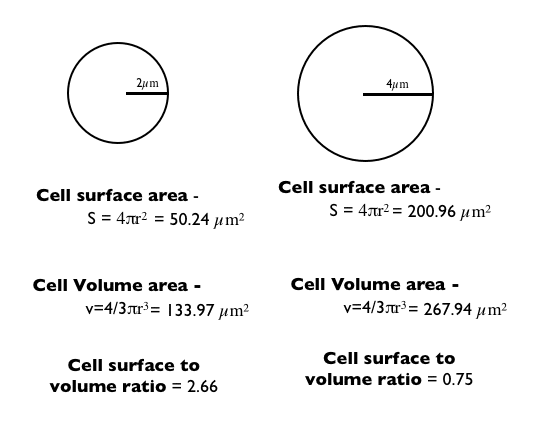Why bacteria are microscopic? It is a vital question that comes to our mind. This article explains the relationship between size of the bacteria and efficiency in absorbing the nutrients. Reading this article will help to understand, why bacteria are microscopic?
Why we cannot see Bacteria:
The human eyes can observe the objects that are wider than 0.04mm. We can distinguish two lines which are 0.026 mm apart. Due to the limitation of our human eye, we cannot observe the bacteria by naked eyes.
Bacteria are Prokaryotes:
Bacteria are single cell organisms. They are prokaryotes. They lack nucleus and membrane bound organelles. To observe and study the bacteria and other microscopic organisms, Scientist have invented Microscope. The microscope has much more resolution than the human eye.
To study known or unknown bacteria, we first conduct the microscopic study. Whenever we observe them under a microscope, we observe their cell shape and size. The study of of bacterial shape, size and arrangements of cells is called as Bacterial Morphology.
Microscopic Bacteria:
Bacteria are microscopic in size (Very few are macroscopic). Bacteria vary in size from 0.2 µm to 700 µm. This microscopic size has its own advantages. To understand the advantages of microscopic cell it is necessary to know the relation of cell surface to volume and how does it affect the size the cell and functionality?
Surface area to volume ratio:
Surface area is defined as the area of outer surface of the cell and volume means the space that is inside the cell. When cell grows in size, the cell membrane expands increasing the internal volume. While increasing in size, the cell volume increase rapidly than cell surface. And hence the availability of surface for molecule to pass to a unit volume of the cell steadily decreases. The surface to volume ratio (SA:V) signifies the area that is available for given size of bacteria.

Let’s take an example of coccus. The formula for surface and volume of circle as follows-
Circle surface area: S= 4 πr2
Circle volume area: V= 4/ 3 π r3
Let’s apply these formula to our cocci shaped bacteria which is also circular in shape
Cocci cell surface area: S= 4 πr2
Cocci cell volume area: V= 4/ 3 π r3

For bigger cell, the S/V ratio is small and for smaller cell S/V ratio is high. larger is the surface area to volume ratio, faster is the accommodation and absorption of nutrients. Hence, the significance of surface area to volume ratio is related to nutrient uptake, metabolism and energy production. The nutrient absorption in bigger cell (i.e. small S/V ratio) is slow and hence reduce the growth rate of cell whereas small cell (i.e. high S/V ratio) favors speedy accommodation of nutrients and hence growth rate is fast.
The microscopic cells needs to maintain the favorable surface area to volume ratio. The bigger cells have small S/V ratio and smaller cells have high S/V ratio. High S/V ratio support high speed of nutrient uptake.
Curiosity Box –
Thiomargarita namibiensis is the world’s largest bacteria, it may grow up to size 750 μm. Due to their large size, they may be visible to human eye.
The Mycoplasma gallicepticum is the smallest bacterium and its size is from 0.2 μm to 0.4μm
References:
http://www.brooklyn.cuny.edu/bc/ahp/LAD/C5/C5_ProbSize.html
https://bio.libretexts.org/Bookshelves/Microbiology
Willey, J. M., Sherwood, L., Woolverton, C. J., & Prescott, L. M. (2008). Prescott, Harley, and Klein’s microbiology. New York: McGraw-Hill Higher Education.
http://www.ndvsu.org/images/StudyMaterials/Micro/Shape-sixe-and-arrangment-of-bacteria-converted.pdf



One thought on “Why Bacteria are Microscopic?”